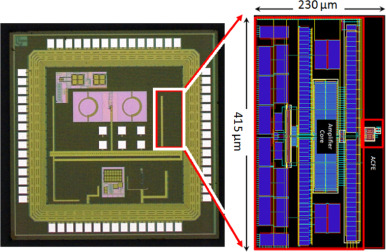This invention introduces an ultra-low noise amplifier designed to enhance the detection of weak biological signals, like those from the brain or during fetal monitoring. Unlike traditional methods that consume a lot of power, this amplifier operates efficiently, making it suitable for portable medical devices. It uses advanced technology to minimize electrical interference and accurately amplify delicate signals, which is crucial for improving medical diagnostics and advancing research in neuroscience.
Bio-potential signals, such as those encountered in EEG and neural amplification, are characterized by extremely low amplitudes, demanding ultra-low noise instrumentation amplifiers for effective signal detection. Existing methods often rely on increased power consumption, which is impractical for battery-operated devices like wearable medical monitors. This creates a pressing need for an innovation that achieves high signal-to-noise ratios without compromising power efficiency, addressing critical applications in medical diagnostics and neural research.
- Silent Signal Amplification: This technology amplifies faint biological signals (like brain waves) with minimal electrical noise, enhancing clarity and accuracy in medical diagnostics.
- Efficient Power Use: It achieves high sensitivity without draining battery power, making it ideal for portable medical devices like wearable monitors.
- Precision Engineering: It uses symmetrical transistor pairs in a smart way to reduce unwanted electrical interference, ensuring clear signal detection.
- Cutting-edge Design: It is designed to match the sensitivity of the human body's own electrical signals, enabling precise measurement without distortion.
This technology has been tested in the lab, and early prototype has been developed.
The test chip is fabricated and tested in the lab.
4
This innovation enhances the accuracy of neurological and fetal monitoring, aiding in early detection and treatment. It facilitates portable, low-power medical devices that can be used anywhere, improving healthcare access in remote areas. It supports breakthroughs in neuroscience by providing clearer data on brain activity, contributing to our understanding of the brain and its disorders.
- Medical Devices: Can be used in EEG (brainwave) monitors to detect and analyze brain activity with high sensitivity and minimal interference
- Fetal Monitoring: Applicable in devices to monitor fetal heartbeats and movements, ensuring accurate and reliable measurements
- Neuroscience Research: Can be employed in laboratories for studying neural signals with precision, contributing to advancements in understanding brain functions and disorders
- Other Industries: Consumer Electronics, Biotechnology
Geography of IP
Type of IP
351/MUM/2015
473407

